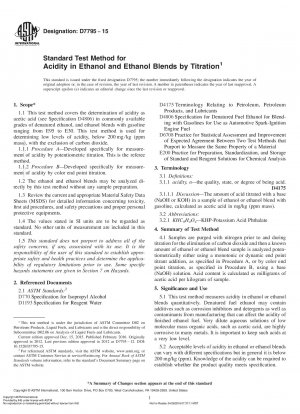ASTM D7795-15
Standard Test Method for Acidity in Ethanol and Ethanol Blends by Titration
- Standard No.
- ASTM D7795-15
- Release Date
- 2015
- Published By
- American Society for Testing and Materials (ASTM)
- Status
- Replace By
- ASTM D7795-15(2022)e1
- Latest
- ASTM D7795-15(2022)e1
- Scope
5.1 This test method measures acidity in ethanol or ethanol blends quantitatively. Denatured fuel ethanol may contain additives such as corrosion inhibitors and detergents as well as contaminants from manufacturing that can affect the acidity of finished ethanol fuel. Very dilute aqueous solutions of low molecular mass organic acids, such as acetic acid, are highly corrosive to many metals. It is important to keep such acids at a very low level.
5.2 Acceptable levels of acidity in ethanol or ethanol blends can vary with different specifications but in general it is below 200 mg/kg (ppm). Knowledge of the acidity can be required to establish whether the product quality meets specification.
1.1 This test method covers the determination of acidity as acetic acid (see Specification D4806) in commonly available grades of denatured ethanol, and ethanol blends with gasoline ranging from E95 to E30. This test method is used for determining low levels of acidity, below 2008201;mg/kg (ppm mass), with the exclusion of carbon dioxide.
1.1.1 Procedure A—Developed specifically for measurement of acidity by potentiometric titration. This is the referee method.
1.1.2 Procedure B—Developed specifically for measurement of acidity by color end point titration.
1.2 The ethanol and ethanol blends may be analyzed directly by this test method without any sample preparation.
1.3 Review the current and appropriate Material Safety Data Sheets (MSDS) for detailed information concerning toxicity, first aid procedures, and safety precautions and proper personal protective equipments.
1.4 The values stated in SI units are to be regarded as standard. No other units of measurement are included in this standard.
1.5 This standard does not purport to address all of the safety concerns, if any, associated with its use. It is the responsibility of the user of this standard to establish appropriate safety and health practices and determine the applicability of regulatory limitations prior to use. Some specific hazards statements are given in Section 7 on Hazards.
ASTM D7795-15 Referenced Document
- ASTM D1193 Standard Specification for Reagent Water
- ASTM D4175 Standard Terminology Relating to Petroleum Products, Liquid Fuels, and Lubricants
- ASTM D4806 Standard Specification for Denatured Fuel Ethanol for Blending with Gasolines for Use as Automotive Spark-Ignition Engine Fuel
- ASTM D6708 Standard Practice for Statistical Assessment and Improvement of Expected Agreement Between Two Test Methods that Purport to Measure the Same Property of a Material
- ASTM D770 Standard Specification for Isopropyl Alcohol
- ASTM E200 Standard Practice for Preparation, Standardization, and Storage of Standard and Reagent Solutions for Chemical Analysis
ASTM D7795-15 history
- 2022 ASTM D7795-15(2022)e1 Standard Test Method for Acidity in Ethanol and Ethanol Blends by Titration
- 2015 ASTM D7795-15 Standard Test Method for Acidity in Ethanol and Ethanol Blends by Titration
- 2012 ASTM D7795-12 Standard Test Method for Acidity in Ethanol and Ethanol Blends by Titration
